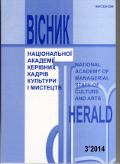SPECIFICITY OF THE ARMENIAN PUBLISHING IN UKRAINE: HISTORICAL DISCOURSE
DOI:
https://doi.org/10.32461/2226-3209.3.2014.138106Keywords:
Armenian, book, illustration, journal, monthly, newspaper, periodical, printer, printing houseAbstract
The scholars were always attracted by the history of the Armenian printing in Ukraine. In the beginning of the 16th century the Lviv Armenian printing house of Hovannes (Yan) Karmatents (Yan Muratovych) became the fourth in
the world after those of Hakob Meghapart in Venice, Abgar Tokhatetsi in Constantinople and the Armenian printing
house in Rome. However, the history of the Armenian printing in Ukraine was not limited only by Y. Karmatents' activity.
Its development is necessary to investigate in several aspects:
1. The first phase of its development is related to Armenians printers in Ukraine till 1615 and concerns the apocryphal Armenian printing houses on the border of the 16th-17th centuries, and the problem of the Armenian origin of Krakow’s printer Lazar Andrisowych and his son Yan Janushovskiy. According to Prof. Y. Dashkevych, the hypothesis about L. Andrisovych's Armenian origin is groundless. Indeed, the family name of Andrisovych is rather untypical for the Ukrainian and Polish Armenians, but this can hardly serve as a proof of non-Armenian origin of its bearers. The name of the notorious Armenian Nicholas Baydulovych, the Head of the department of Lviv's translators in the XVII century, would be a good evidence of this viewpoint. Prof. E.Tryiarskyi names a number of famous Armenians in the XVII – XVIII century Warsaw, with a very similar family name which sounds as Andrikhovych (or Andrykhovych). Probably, the Matthew Bernat’s printing house has served as a base for the hypothesis about the Armenian printing houses in Lviv on a boundary of the 16th-17th centuries, because the family name Bernat (Pernat) is totally unlike Polish surnames, whereas such surname as Beranatovich (Bernatens – Pernatens) was quite common among the Armenians of Western Ukraine in the XVI – XIX centuries. For example, in 1592 the famous Armenian Gospel of Skevry turned out to have been kept by Armenian Toros Pernatens, the son of Zatik. Thus, it is very likely that Pernat was an Armenian;
2. Jan Karmatents (Hovhannes Karmatents – by his grandfather, Jan Muratovych – by his father) had managed
to type only three books in his print shop. His printing press in Lviv had only worked from 1616 till 1618. It was probably closed due to financial problems. The first two books were written in Armenian: "Book of Psalms", dated by 1616, is now kept in the Mkhitarists library on the island of St. Lazarus in Venice, and the so-called "Doctor's Handbook", which had been kept in the same library and was destroyed by the fire in 1815. The last one, "Book of Prayers", published in 1618, is the only book in the world printed in Armenian-Kipchak language. It was discovered in the University Library of Leiden by the famous Hungarian Armenologist prof. E. Schütz in the early 1960's. After Karmatents died in 1624 no traces of his print shop's activities are found;
3. In the 2nd half of the 17th century the numerous attempts to create the Armenian printing house in Lviv were
undertaken by Theatines, then – by Co-adjutor (subsequently, the Lviv Armenian-Catholic archbishop-metropolitan)
Vardan Hunanian. However after the Armenian-Catholic reforms the Armenians of Ukraine have gradually replaced the Armenian language of colloquial and liturgical Polish, Ukrainian languages and Latin, so the necessity for creation of new Armenian printing house has disappeared. The need in Armenian books was satisfied due to Armenian printing houses of Vienna and Venice Mechitarists, and also the Amsterdam and Constantinople Armenian printing houses;
4. The development of Armenian book-printing the Crimea in the 19th century is closely connected with the educational activity of Archimandrite Gabriel Aivazovsky. In 1858, thanks to his efforts, the famous Halibov's school was opened in Feodosia. Upon the Archimandrite's request, there were also created a print shop and book stores there. The print shop would publish textbooks and scientific papers in Armenian language, among which there was the two-volume "History of the Armenians of the Crimea" by O.Ter-Abrahamian (1865). G. Aivazovsky also resumed production of two periodicals in Armenian: "The Dove of Masis" and "The Rainbow of Armenia". In 1870th there was published periodical "Dastiarak"
5. The last phase of Armenian printing in Ukraine concerns the 19th-1st half of the 20th centuries and is connected with the Odessa’s newspaper "Mshak", a monthly "Armenia and a war" (1918), a historian-literary weekly journal "Bulletin of Armenia" (1918-1920); the Lviv periodicals " The Herald of St. Grigory" (1927-1939) and "Grigoriana" (1935-1938), the Kharkiv newspapers "Karmir Yugir" and "Sotsarshav" (1933).
6. The special attention must be focused on the phenomena of book illustrations of the Armenian artists in Ukraine (Joseph and Adam Gochemski, Kaetan Stefanowych, Julian Makarewych, etc.).
Downloads
Published
Issue
Section
License
Authors who publish with this journal agree to the following terms:
1. Authors retain copyright and grant the journal right of first publication with the work simultaneously licensed under a Creative Commons Attribution License International CC-BY that allows others to share the work with an acknowledgement of the work's authorship and initial publication in this journal.
2. Authors are able to enter into separate, additional contractual arrangements for the non-exclusive distribution of the journal's published version of the work (e.g., post it to an institutional repository or publish it in a book), with an acknowledgement of its initial publication in this journal.
3. Authors are permitted and encouraged to post their work online (e.g., in institutional repositories or on their website) prior to and during the submission process, as it can lead to productive exchanges, as well as earlier and greater citation of published work (See The Effect of Open Access).


